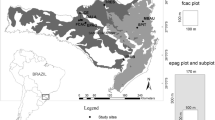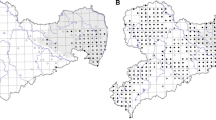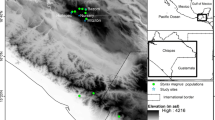Abstract
We quantified the within-population genetic variation of Couratari multiflora and C. guianensis, two tree species found in terra firme forests of central Amazonia. Both species have some ecological features in common, but they differ in population abundance across their geographic ranges. While C. multiflora has been found only in low-density populations in all sites studied to date, C. guianensis is relatively common in some sites and very scarce in others. In a 400-ha plot, we found 41 and 29 adults of C. multiflora and C. guianensis, respectively. Twenty-two saplings of C. guianensis and 103 seedlings of C. multiflora were also examined. The mean expected heterozygosities (Hem) of seedlings and adults of C. multiflora were 0.431 and 0.436, and the mean fixation indices (Fm), 0.114 and 0.176, respectively. For C. guianensis, saplings and adults presented Hem equal to 0.425 and 0.429, and the Fm were 0.393 and 0.527, respectively. These low-density populations of two congeneric species did not differ in terms of genetic diversity, but rather they differed in terms of mean observed heterozygosity (Hom), and therefore Fm. The species with variable population density had lower Hom and greater Fm relative to the species that is always found in low-density.
Similar content being viewed by others

References
Alfenas AC, Peters I, Brune W and Passador GC (1991) Eletroforese de proteínas e isoenzimas de fungos e essências florestais. Imprensa Universitária, Universidade Federal de Viçosa
Viçosa Alvarez-Buylla E and Garay AA (1994) Population genetic structure of Cecropia obtusifolia, a tropical pioneer tree species. Evolution 48: 437–453
Baker HG (1959) Reproductive methods as factors in speciation in flowering plants. Cold Spring Harbor Symposium of Quantitative Biology 24: 177–199
Bawa KS and Asthon PS (1991) Conservation of rare trees in tropical rain forests: a genetic perspective. In: Falk DA and Holsinger KE (eds) Genetics and Conservation of Rare Plants, pp 62–74. Oxford University Press, New York
Brown AHD and Weir BS (1983) Measuring genetic variability in plant populations. In: Tanskley SD and Orton TJ (eds) Isozymes in Plants Genetics and Breeding (Part A), pp 219–239. Elsevier Science Publishers, Amsterdam
Brown AHD, Matheson AC and Eldridge KG (1975) Estimation of the mating system of Eucalyptus obliqua L'Herit using allozyme polymorphisms. Australian Journal of Botany 23: 931–949
Brown JH, Mehlman DW and Stevens GC (1995) Spatial variation in abundance. Ecology 76: 2028–2043
Charlesworth D and Charlesworth B (1987) Inbreeding depression and its evolutionary consequences. Annual Review of Ecology and Systematics 18: 237–268
Clark PJ and Evans FC (1954) Distance to nearest neighbor as a measure of spatial relationships in populations. Ecology 35: 445–453
Clayton J and Tretiak D (1972) Amine-citrate buffers for pH control in starch gel electrophoresis. Journal of Fisheries Research Board of Canada 29: 1169–1172
Corner EJH (1954) The evolution of tropical forests. In: Huxley J, Hardy AC and Ford EB (eds) Evolution as a Process, pp 34–36. Allen and Unwin, London
Eguiarte LE, Perez-Nasser N and Piñero D (1992) Genetic structure, outcrossing rate and heterosis in Astrocaryum mexicanum (tropical palm): Implications for evolution and conservation. Heredity 69: 217–228
Ellstrand NC and Elam DR (1993) Population genetic consequences of small population size: implications for plant conservation. Annual Review of Ecology and Systematics 24: 217–242
Gentry AH (1990) Four Neotropical Rainforests. Yale University Press, London
Hall P, Walker S and Bawa K (1996) Effect of forest fragmentation on genetic diversity and mating system in a tropical tree Pithecellobium elegans. Conservation Biology 10: 757–768
Hamrick JL (1994) Genetic diversity and conservation in tropical forests. In: Drysdale RM, John SET and Yapa AC (eds) Proceedings International Symposium on Genetic Conservation and Production of Tropical Forest Tree Seed, pp 1–9. Asian-Canada Forest Tree Seed Centre
Hamrick JL and Murawski DA (1991) Levels of allozyme diversity in populations of uncommon neotropical tree species. Journal of Tropical Ecology 7: 395–399
Hubbell SP and Foster RB (1986) Commonness and rarity in a neotropical forest: implications for tropical tree conservation. In: Soulé ME (ed) Conservation Biology: Science of Scarcity and Diversity, pp 205–231. Sinauer Associates, Sunderland, MA
Husband BC and Barrett CH (1996) A metapopulation perspective in plant population biology. Journal of Ecology 84: 461–469
Kephart SR (1990) Starch gel electrophoresis of plant isozymes: a comparative analysis of techniques. American Journal of Botany 77: 693–712
Lepsch-Cunha N (1996) Estrutura genética e fenologia de espécies raras de Couratari spp. (Lecythidaceae) na Amazônia central. PhD dissertation. ESALQ/USP, Piracicaba, SP, Brasil
Lepsch-Cunha N and Gascon C (1999) The genetics of rare tropical trees: implications for conservation of a demographically heterogeneous group. In: Bierregaard Jr R and Gascon C (eds) Lessons from Amazonia: The Ecology and Conservation of a Fragmented Forest, Yale University Press, London (in press)
Lepsch-Cunha N and Mori S (1999) Reproductive phenology and mating potential in a low-density tree population of Couratari multiflora (Lecythidaceae) in central Amazonia. Journal of Tropical Ecology 15: 97–121
Lovejoy TER and Bierregard Jr RO (1990) Central Amazonian forests and the minimum critical size of ecosystems project. In: Gentry AH (ed) Four Neotropical Rainforest, pp 60–74. Yale University Press, London
Ludwig JA and Reynolds JF (1988) Statistical Ecology. John Wiley, Toronto
Mitchell JD and Mori SA (1987) Ecology. In: Mori SA et al. (eds) The Lecythidaceae of a Lowland Neotropical Forest: La Fumée Mountain, French Guiana, Memoirs of the New York Botanical Garden 44: 113–123
Mori SA and Boeke J (1987) Pollination. In: Mori SA et al. (eds) The Lecythidaceae of a Lowland Neotropical Forest: La Fumée Mountain, French Guiana, Memoirs of the New York Botanical Garden 44: 137–155
Mori SA and Lepsch-Cunha N (1995) Lecythidaceae of a central amazonian moist forest. Memoirs of the New York Botanical Garden 75: 1–55
Mori SA and Prance GT (1990) Lecythidaceae – Part II. The zygomorphic-flowered New World genera (Couropita, Corythophora, Bertholletia, Couratari, Eschweilera and Lecythis). Flora Neotropica 21: 1–376
Mori SA et al. (1987) The Lecythidaceae of a Lowland Neotropical forest: La Fumée Mountain, French Guiana, Memoirs of the New York Botanical Garden 44: 1–190
Murawski DA (1995) Reproductive biology and genetics of tropical trees from a canopy perspective. In: Lowman MD and Nadkarni NM (eds) Forest Canopies, pp 457–493. Academic Press, San Diego, CA
Murawski DA and Hamrick JL (1991) The effect of the density of flowering individuals on the mating systems of nine tropical tree species. American Journal of Botany 74: 1143–1149
Murawski DA, Dayanandan B and Bawa KS (1994) Outcrossing rates of two endemic Shorea species from Sri Lanka tropical rain forests. Biotropica 26: 23–29
Murphy RW, Sites JW, Byth DG and Haufler CH (1990) Proteins I: isozyme eletrophoresis. In: Hillis DM and Moritz C (eds) Molecular Systematics, pp 373–409. Sinauer Associates, Sunderland, MA
Nason JD and Hamrick JL (1997) Reproductive and genetic consequences of forest fragmentation: two case studies of Neotropical canopy trees. The Journal of Heredity 88: 264–276
Nason JD, Aldrich PR and Hamrick JL (1997) Dispersal and the dynamics of genetic structure in fragmented tropical tree populations. In: Laurance WF and Bierregaard Jr RO (eds) Tropical Forests Remnants: Ecology, Management, and Conservation of Fragmented Communities, pp 304–320. The University of Chicago Press, Chicago/London
Nei M (1978) Estimation of average heterozygosity and genetic distance from a small number of individuals. Genetics 89: 583–590
Nei M (1987) Molecular Evolutionary Genetics. Columbia University Press, New York
Nelson BW, Absy ML, Barbosa EM and Prance GT (1985) Observations on flower visitors to Bertholletia excelsa H.B.K. and Couratari tenuicarpa A.C.Sm. (Lecythidaceae). Acta Amazonica 15: 225–234
O'Malley DM and Bawa KS (1987) Mating system of a tropical rain forest tree species. American Journal of Botany 74: 1143–1149
O'Malley DM, Buckley DP, Prance GT and Bawa KS (1988) Genetics of Brazil nut Bertholletia excelsa Humb and Bonpl.: Lecythidaceae. 2. Mating system. Theoretical Applied Genetics 76: 929–932
Prance GT, Rodrigues WA and Silva MF (1976) Inventário Florestal de 1 hectare de Mata de terra firme – km 30 da Estrada Manaus-Itacoatiara. Acta Amazonica 6: 9–35
Rabinowitz D (1981) Seven forms of rarity. In: Synge H (ed) The Biological Aspects of Rare Plants Conservation, pp 205–218. John Wiley, New York
Rankin-de-Merona JM and Ackerly DD (1987) Estudos populacionais de árvores em florestas fragmentadas e as implicaçÕes para a conservação 'in situ' das mesmas na floresta tropical da Amazônia Central. Revista IPEF 35: 47–59
Schoener TW (1987) The geographical distribution of rarity. Oecologia 74: 161–173
Soltis DE and Soltis PS (1990) Isozymes in Plant Biology. Chapman and Hall, London
Stacy EA, Hamrick JL, Nason JD, Hubbell SP, Foster RB and Condit R (1996) Pollen dispersal in lowdensity populations of three neotropical tree species. The American Naturalist 148: 275–298
Swofford D and Selander RB (1989) Byosys-1. A computer program for the analysis of allelic variation in population genetics and biochemical systematics. Release 1,7. Illinois Natural History Survey, Illinois
Weir BS (1990) Genetic data analysis. Sinauer Associates, Sunderland, MA
Wright S (1965) The interpretation of population structure by F-statistics with special regard to systems of mating. Evolution 19: 395–420
Wright S (1978) Evolution and The Genetics of Populations, Vol 4. Variability within and among Natural Populations. University of Chicago Press, Chicago, IL
Yeh FC (1979) Analyses of gene diversity in some species of conifers. In: Conkle MT (ed) Proceedings of the Symposium on Isozymes of North American Forest Trees and Forest Insects, pp 1–11. General Technical Report PSW-48, Pacific Southwest Forest and Range Experiment Station, USDA Forest Service, Berkeley, CA
Author information
Authors and Affiliations
Rights and permissions
About this article
Cite this article
Lepsch-Cunha, N., Kageyama, P.Y. & Vencovsky, R. Genetic diversity of Couratari multiflora and Couratari guianensis (Lecythidaceae): consequences of two types of rarity in central Amazonia. Biodiversity and Conservation 8, 1205–1218 (1999). https://doi.org/10.1023/A:1008979010728
Issue Date:
DOI: https://doi.org/10.1023/A:1008979010728



